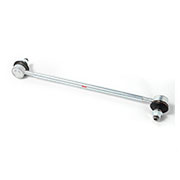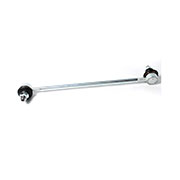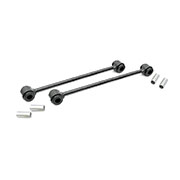
Our experience and expertise in automobile industry helps us to make suspension and steering parts as per your specification with high quality and finishing.
What is a stabilizer link in a car?
An anti-roll bar (anti-sway bar, sway bar, stabilizer bar) is a part of many automobile suspensions that helps reduce the body roll of a vehicle during fast cornering or over road irregularities. It connects opposite (left/right) wheels together through short lever arms linked by a torsion spring.
An anti-sway or anti-roll bar is intended to force each side of the vehicle to lower, or rise, to similar heights, to reduce the sideways tilting (roll) of the vehicle on curves, sharp corners, or large bumps. With the bar removed, a vehicle's wheels can tilt away by much larger distances.
Although there are many variations in design, a common function is to force the opposite wheel's shock absorber, spring or suspension rod to lower, or rise, to a similar level as the other wheel. In a fast turn, a vehicle tends to drop closer onto the outer wheels, and the sway bar soon forces the opposite wheel to also get closer to the vehicle. As a result, the vehicle tends to "hug" the road closer in a fast turn, where all wheels are closer to the body. After the fast turn, then the downward pressure is reduced, and the paired wheels can return to their normal height against the vehicle, kept at similar levels by the connecting sway bar.
Principles
A sway bar is usually a torsion spring that resists body roll motions. It is usually constructed out of a cylindrical steel bar, formed into a "U" shape, that connects to the body at two points, and at the left and right sides of the suspension. If the left and right wheels move together, the bar rotates about its mounting points. If the wheels move relative to each other, the bar is subjected to torsion and forced to twist. Each end of the bar is connected to an end link through a flexible joint. The sway bar end link connects in turn to a spot near a wheel or axle, transferring forces from a heavily-loaded axle to the opposite side.
Forces are therefore transferred:
- from the heavily-loaded axle
- to the connected end link via a bushing
- to the anti-sway (torsion) bar via a flexible joint
- to the connected end link on the opposite side of the vehicle
- to the opposite axle
The bar resists the torsion through its stiffness. The stiffness of an anti-roll bar is proportional to the stiffness of the material, the fourth power of its radius, and the inverse of the length of the lever arms (i.e., the shorter the lever arm, the stiffer the bar). Stiffness is also related to the geometry of the mounting points and the rigidity of the bar's mounting points. The stiffer the bar, the more force required to move the left and right wheels relative to each other. This increases the amount of force required to make the body roll.
Main Functions
Anti-roll bars provide two main functions. The first function is the reduction of body lean. The reduction of body lean is dependent on the total roll stiffness of the vehicle. Increasing the total roll stiffness of a vehicle does not change the steady state total load (weight) transfer from the inside wheels to the outside wheels, it only reduces body lean. The total lateral load transfer is determined by the CG height and track width.
The other function of anti-roll bars is to tune the handling balance of a car. Understeer or oversteer behavior can be tuned out by changing the proportion of the total roll stiffness that comes from the front and rear axles. Increasing the proportion of roll stiffness at the front increases the proportion of the total load transfer that the front axle reacts to—and decreases the proportion that the rear axle reacts to. In general, this makes the outer front wheel run at a comparatively higher slip angle, and the outer rear wheel to run at a comparatively lower slip angle, which is an understeer effect. Increasing the proportion of roll stiffness at the rear axle has the opposite effect and decreases understeer.






